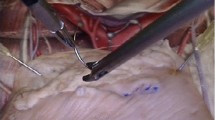Abstract
Background
The ability to make an objective evaluation of a surgeon’s operative ability remains an elusive goal. In this study, we used motion analysis as a measure of dexterity in the performance of a simulated operation.
Methods
Fifteen surgeons performed a total of 45 laboratory-based laparoscopic cholecystectomies on a cadaveric porcine liver model. Subjects were assigned to one of three groups according to their level of experience in human laparoscopic cholecystectomy. Electromagnetic tracking devices were used to analyze the surgeon’s hand movements as they performed the procedure. Movement data (time, distance, number of movements, and speed of movement) were then compared.
Results
Analysis of variance (ANOVA) movement scores across the three groups showed significantly better performance among the experienced laparoscopic surgeons than the novices. Learning curves across repetititions of procedures were plotted. Novices made more improvement than experts.
Conclusions
Motion analysis provides useful data for the assessment of laparoscopic dexterity, and the porcine liver model is a valid simulation of the real procedure.
Similar content being viewed by others
References
Treasure T (1998) Lessons from the “Bristol Case”: more openness on risks and on individual surgeons’ performance. Br Med J 316: 1685–1686
Hanna GB, Drew T, Clinch P, Hunter B, Cuschieri A (1998) Computer-controlled endoscopic performance assessment system. Surg Endosc 12: 997–1000
Hanna GB, Drew T, Cuschieri A (1997) Technology for psychomotor skills testing in endoscopic surgery. Semin Laparosc Surg 4: 120–124
Hanna GB, Frank TG, Cuschieri A (1997) Objective assessment of endoscopic knot quality. Am J Surg 174: 410–413
Macmillan AI, Cuschieri A (1999) Assessment of innate ability and skills for endoscopic manipulations by the Advanced Dundee Endoscopic Psychomotor Tester: predictive and concurrent validity. Am J Surg 177: 274–277
Reznick R, Regehr G, MacRae H, Martin J, McCulloch W (1997) Testing technical skill via an innovative “bench station” examination. Am J Surg 173: 226–230
Reznick RK, Colliver J, Williams RG, Folse JR (1989) Reliability of different grading systems used in evaluating surgical studients. Am J Surg 157: 346–349
Rosenbaum DA (1991) Psychological foundations. Human motor control. Academic Press London, pp 79–118
Rosser JC, Rosser LE, Savalgi RS (1997) Skill acquisition and assessment for laparoscopic surgery. Arch Surg 132: 200–204
Royston C, Lansdown M, Brough W (1994) Teaching laparoscopic surgery: the need for guidelines. Br Med J 308: 1023–1025
Sanders AF (1991) Simulation as a toll in the measurement of human performance. Ergonomics 34: 995–1025
Smith R (1998) All changed, changed utterly: British medicine will be transformed by the Bristol case. Br Med J 316: 1917–1918
Smith S, Wan A, Taffinder N, Read S, Emery R, Darzi A (1999) Early experience and validation work with Procedicus VA: the Prosolvia virtual reality shoulder arthroscopy trainer. Stud Health Technol Inform 62: 337–343
Spencer F (1978) Teaching and measuring surgical techniques: the technical evaluation of competence. Bull Am Coll Surg 63: 9–12
Taffinder N, McManus I, Russell R, Darzi A (1998) An objective assessment of laparoscopic psychomotor skills: the effect of a training course on performance. Surg Endos 12: 493
Taffinder NJ, McManus IC, Jansen J, Russell RCG, Darzi A (1998) An objective assessment of surgeons’ psychomotor skills: validation of the MIST-VR laparoscopic simulator. Br J Surg 85 (Suppl): 75
Taffinder N, Smith S, Mair J, Russell R, Darzi A (1999) Can a computer measure surgical precision? reliability, validity and feasibility of the ICSAD. Surg Endos 13 (Suppl 1): 81
Author information
Authors and Affiliations
Rights and permissions
About this article
Cite this article
Smith, S.G.T., Torkington, J., Brown, T.J. et al. Motion analysis. Surg Endosc 16, 640–645 (2002). https://doi.org/10.1007/s004640080081
Received:
Accepted:
Published:
Issue Date:
DOI: https://doi.org/10.1007/s004640080081




